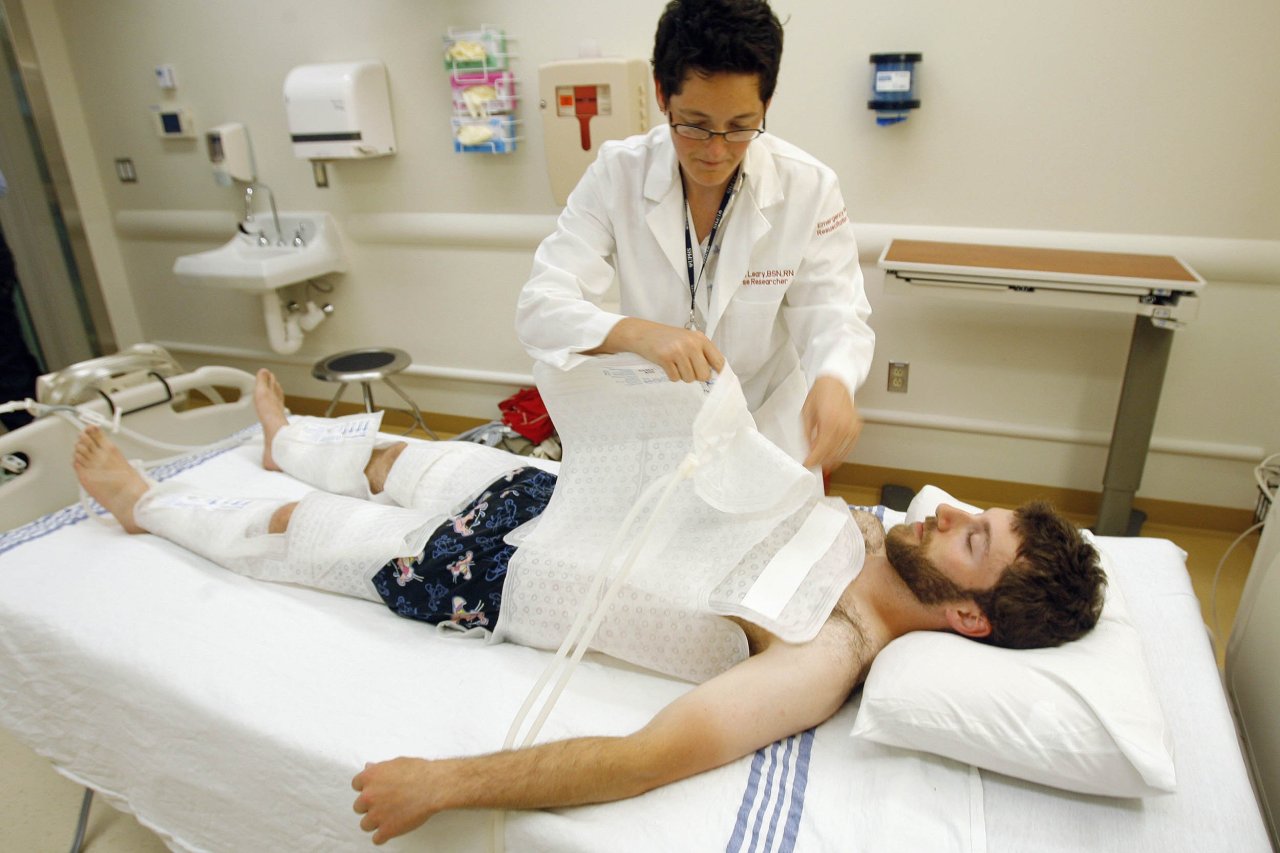Chris Brooks was a healthy 22-year-old, working part time in construction and finishing up his last year in college. One evening, he went out bowling with friends, returned home to his parents' house in Middletown Township, Pennsylvania, and lay down on the couch to sleep. Then his parents noticed something strange: He appeared to have stopped breathing.
His mother shook him. No response. She panicked and called 911, but by the time the paramedics arrived, Brooks's heart hadn't been beating for nearly 15 minutes. He was in cardiac arrest. The paramedics were able to resuscitate Brooks by administering an electric shock to the heart, getting him to breathe again, but he wasn't yet in the clear.
Typically, a person who goes over five minutes without heartbeat, blood flow or oxygen is in serious danger of permanent brain damage. Less than 10 percent of those who suffer an out-of-hospital cardiac arrest survive, because it usually takes much longer than five minutes to get such people from their home to the help they need. And among those who survive, about 1 in 10 will have severe brain damage.
To reduce the damage to his brain and organs, Brooks was rushed to the University of Pennsylvania, where Dr. Lance Becker and his team cooled the young man's core temperature to below 90 degrees Fahrenheit—a process called "induced hypothermia." This is often done to cardiac arrest patients, either by injecting them with a cold saline solution or placing ice packs on them to increase their chances of complete recovery.
The dose of cold saved his life. Brooks had no brain damage, a remarkable feat that has led doctors to explore more ways to use induced hypothermia in emergency settings.
Now Dr. Sam Tisherman and his team at the University of Maryland, in collaboration with the University of Pittsburgh, plan to put 10 patients into a more severe form of hypothermia than what Brooks got, something known as "suspended animation." They'll flush their bodies with a cold fluid, cooling (and therefore preserving) tissue. The experimental trial, known as emergency preservation and resuscitation for cardiac arrest from trauma (EPR-CAT), is funded by the U.S. Department of Defense, and it is the first time doctors are harnessing profound hypothermia (pushing body temperatures to as low as 50 degrees) to save lives.
"[When] people think of [suspended animation], they think about space travelers being frozen and woken up on Jupiter, or Han Solo in Star Wars," Tisherman, a professor of surgery at the University of Maryland, recently told the BBC. "That doesn't help, because it's important for the public to know it's not science fiction—it's based on experimental work and is being studied in a disciplined manner, before we use it to stop people dying."
Slowing Death's Spiral
Cooling your body down even just one or two degrees from its normal core temperature of 97.5 to 99 degrees will make you shiver relentlessly; once you're down to 90 degrees or lower, you will begin to experience sluggishness, apathy and mental impairment. Then it's only a few hours before your organs fail and you freeze to death.
But hypothermia—when your core body temperature drops so low that normal metabolism and bodily functions cease—is something of a medical contradiction. Though it can lead to death, it can also slow down the dying process. It all depends on timing.
The remarkable case of Anna Bågenholm shows how dangerous—and protective—extreme cold can be. In 1999, the 29-year-old Swedish radiologist was skiing in Norway when she fell into a frozen stream, becoming trapped headfirst under a 7-inch layer of ice. After 40 minutes, she suffered circulatory arrest; she wasn't pulled out until over an hour after falling in. Yet the severe cold had cooled down her brain and body to a core temperature of 56.7 degrees, and after being rescued and revived, she woke up without any brain damage and recovered completely after a few months.
"We know that if you've been under warm water for three to four minutes, you're basically unsalvageable," says Dr. Gordon Giesbrecht, a physiologist at the University of Manitoba in Canada. "But if you've fallen and slipped underneath the ice, you may survive 30 to 40 minutes of drowning. Given that the oxygen supply to the brain has stopped, a colder brain can survive a longer period of anoxia."
Death is not like falling off the edge of a cliff. It's a much more gradual process, involving something akin to a chain reaction within the cells. "There are pathways that lead the cell toward death, and we know that when a person gets in critical condition, many of those pathways are activated," says Becker. "So the cells begin to spiral toward death. [But] cooling slows down that death spiral."
With hypothermia, that period of time in between life and death might more accurately be called a "hibernation-like state," or temporary death, Becker explains.
There are stories of young children surviving for several hours in the freezing cold after entering a hibernation-like state spurred by hypothermia. Erika Nordby, "Canada's miracle child," was revived after spending two hours without a heartbeat in the snow, her core body temperature reaching 61 degrees. And there's Bågenholm, who also lived to tell her chilling tale. These cases give hope to doctors who aim to use hypothermia in a controlled, clinical setting.
An Ice Pack to the Groin
Therapeutic hypothermia dates as far back as the Napoleonic Wars in the early 1800s, when a surgeon working with troops observed that wounded soldiers who were warmer and closer to the fire fared worse than his patients out in the cold.
Led by hypothermia pioneer Dr. Peter Safar, doctors began applying hypothermia experimentally in the ER during the 1950s and 1960s, using it to reduce tissue injury and brain damage from lack of blood flow, particularly in cardiac arrest and stroke patients. They found that by decreasing the brain's demand for oxygen, hypothermia lessened the production of neurotransmitters, slowed down brain activity and reduced the amount of free radicals that might damage the brain. Icing the whole body down for about 24 hours protected other organs too, including the kidneys and liver. "Mild cooling… by even two or three degrees could make much of a difference" in saving someone's life, Becker says, and doing the opposite—warming someone up—made the person less likely to survive.
The current standard of care after cardiac arrest involves cooling the patient to "mild hypothermia" at 90 to 93 degrees for 12 to 24 hours. After suffering cardiac arrest, a patient is given cardiopulmonary resuscitation to get the heart beating again; in the emergency room, doctors then use cooling blankets, wet towels and ice packs placed on the groin or neck to induce mild hypothermia. This is what saved Chris Brooks.
A similar mechanism may have preserved former Buffalo Bills tight end Kevin Everett's ability to walk. During a 2007 game, he suffered a life-threatening spinal cord injury that left him temporarily paralyzed. Doctors used cold therapy to reduce inflammation and damage, which may have been critical in protecting his nervous system after the trauma. Today, he is walking again.
Drain the Blood
EPR-CAT is a far more risky and experimental procedure than the standard cooling. In the University of Pittsburgh trial, doctors plan to push the temperatures of patients as low as 50 to 59 degrees—much lower than anything tried in the past. They'll do it by flushing the patients' blood with an ice-cold saline solution. This, Tisherman says, "has not yet been done in humans."
Tisherman hypothesizes that flooding the blood of trauma patients with extremely cold fluid will allow them to "tolerate not having [blood] flow while the surgeon tries to find and control the bleeding" after a gunshot wound or other form of traumatic blood loss. Unlike cardiac arrest from heart disease cases, people whose hearts stop due to trauma and blood loss cannot be resuscitated simply by CPR, which is why such cold temperatures are being used. During EPR-CAT, doctors place a large tube into the aorta and flush cold saline, a salty fluid, through the body. Afterward, a heart-lung bypass machine would be used to revive blood circulation and oxygenation.
The method has been attempted on animals. A 2006 study examined the impact of "deep" (59 degrees), "profound" (50 degrees) and "ultra-profound" (41 degrees) hypothermia in pigs with uncontrolled bleeding wounds and found that the animals that underwent profound hypothermia had the highest survival rates. In 2000, researchers flushed the arteries of dogs in cardiac arrest with ice-cold saline, finding that it improved their chances of survival with no brain damage.
But, as with any new human experimental treatment, there are concerns. Doctors know that if not implemented properly, hypothermia may reduce the blood's ability to clot (certain drugs will be needed to maintain blood clotting). And it's possible that even after inducing profound hypothermia, the patient will be resuscitated but have brain damage.
"The trick would be the implementation," Becker says. "Draining the blood out and rapidly cooling a person to a deep level—we try to do it every day, and it's just doggone hard to do.… But I would say it's very likely that the idea is correct."
If successful, the trial could revolutionize resuscitation research. "Right now, with our current resuscitation strategies for cardiac arrest, less than 1 in 10 survive," Tisherman says. "If we can bring that up to 15 percent or 20 percent, that would potentially be a game-changer."



















